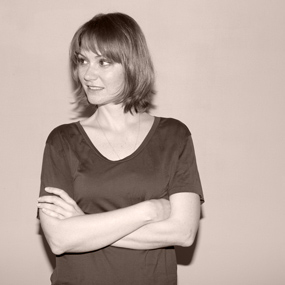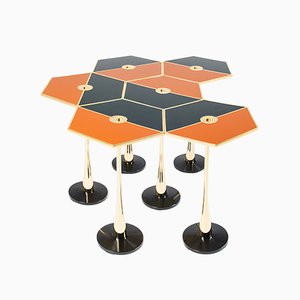A colorful visit with a Milan design legend
The Many Faces of Anna Gili
With a three-decade-long career that unfolded smack in the heart of the Milan art and design scene, Anna Gili doesn’t need to mince words. In one moment, she charges that “the world of work is a battlefield where one must fight every day; nothing is given, and everything you get must be seized.” And in the next, she cheers, “Be patient, and let pleasure and amusement lead your work. Work, just as life, is a long path, so it’s important to choose your own way.”
Complexities—even contradictions—run rampant throughout her practice, from her furniture designs and graphics to her performance art and academic teachings. Many of her chairs, tables, and objects, for instance, are imbued with human, animal, or plant forms, often appearing as if they might get up and walk across the room. Still, these designs do not look to be plucked directly from nature; the exaggerated, vividly hued stylization brings to mind the imaginary worlds of children’s books and cartoons. That is to say, they are at once familiar and alien, biomorphic and artificial.
“I think the way that I conduct my work is the fruit of a lot of experience,” explains Gili, going on to say that her very personal approach has been heavily informed by “many encounters with masters of design—whom I’ve had the great fortune to work with—as well as leading Italian and foreign companies, international artists, my animal friends, and even the humanistic culture of Central Italy.”
When Gili talks about “masters of design,” she isn’t overstating the facts. She graduated from Istituto Superiore per le Industrie Artistiche (I.S.I.A.) in Florence in 1984, right at the height of Memphis and Studio Alchimia mania. Her performative thesis project, Sonorous Garment, drew immediate attention from the radical, postmodern design luminaries of the day. By 1985, she was invited to exhibit in the landmark Triennale di Milano exhibition Elective Affinities, alongside the likes of Mario Botta , Michael Graves, Alessandro Mendini, Tobia Scarpa, Ettore Sottsass, and Robert Venturi. That same year, she produced her first collection for Alessi, her exuberantly sculptural Cro Vases, and, the next, she started contributing to Studio Alchimia’s iconoclastic output. Mendini, in particular, would become a long-time close friend and collaborator; he even named one of his designs in her honor, the Anna G Corkscrew for Alessi (1993).
The spirit of protest, playfulness, and idealism that defined Gili’s early experiences in the 1980s never left her. “When I began my academic-artistic-professional career,” says Gili, “Italian design was going through a moment of great energy; it was an international point of reference. I am grateful for the avant-garde movement because it laid a path, opening design to a new frontier. And it’s thanks to this movement that I felt the freedom to explore design in 360° and the drive to bring design research into art.”
Like many of Gili’s “anti-design” contemporaries, she was never content to merely produce more goods for the mass market; yet her particular mode of disrupting business-as-usual went beyond the antipathy to consumerism preached by friends like Mendini. Gili recognized that the mere fact that she was a woman made her an outsider in design’s boys club. She drew inspiration from the way feminist artists such as Rebecca Horn and others associated with the Body Art movement demanded that female experience be acknowledged. Intrigued by the power of intuition, she went on to study zoosemiotics—non-verbal communication among animals—and proxemics—the amount of distance people feel they need from other people in order to be comfortable. Along the way, driven by her own curiosities, Gili has carved out space within the larger design world for those topics traditionally relegated to the category of the feminine.
Seeing the world in a sort of yin-yang binary, Gili says, “The female universe seeks to represent what is not visible—the chaos—because the female is more linked to life. As a result, women tend to prefer the emotional and spiritual aspects of an object to the technical and functional. And women tend to see a project in a more systematic way, in contrast to the customarily linear nature of thought that belongs to the male. Chaos is the foundation of creativity. The male nature tries to grab it and dominate it, but the female nature remains open to feel, understand, think, and observe. The female is not afraid, and a woman by nature is never complacent within the system.”
When Gili started out, designers were rebelling against what she calls the “bulimic” design system, in which the success of large companies depends on continuously churning out ever more stuff in ever more efficient ways while feeding consumers’ desires for novelty and status symbols. From the get-go, this notion fit perfectly with her own considered, symbolically laden approach. And, according to Gili, her mission hasn’t changed over the years because the system hasn’t changed.
“The design system in Italy is one of the most complex in the world—well structured and internationally regarded. At the same time, it has acquired too many old habits and certainties, suppressing approaches that encroach upon its power,” she says. “These aspects don’t allow for much renewal. We’re lacking a wide-ranging strategy that can conduct Italian design beyond its historical experience, through an outlet of deep conscience. The system of Italian design has lived too long on rent, without trying to cultivate experimentation in a qualified way.”
For Gili, the way forward involves looking to the past—way into the past—while observing the natural world. She ties this romantic, emotion-driven point of view to her upbringing in Orvieto, where the landscape, together with the legacy of Umbria’s religious and cultural products from the 11th through the 14th centuries, enchanted her as a child. The Benedictine rule, Ora et Labora, which promotes a synergy between prayer and work, contemplation and action, is fundamental to her practice. Her visual language, meanwhile, has grown out of her life-long exposure to medieval iconography, Renaissance painting, and humanist thought. And her unique fascination with the animal kingdom was forged “during my childhood summers, when I used to fall asleep in the afternoon to the intense singing sounds of the cicadas, and in the evenings, when I used to chase the fireflies. I re-evoke this communion with nature wherever I am, even when I’m in my studio in Milan.”
The resonance of Gili’s approach—at once studied and personal, contemplative and intuitive—is arguably what allows her to operate so freely within the very system she works to critique. She is consistently commissioned to design objects by a number of the big brands—Bisazza, Cappellini, Cassina, and Salviati, to name a few—and to present her work in far-flung institutions and art spaces, ranging from the Indianapolis Museum of Art and the Kunstmuseum Dusseldorf to Centre Pompidou in Paris and the Seoul Arts Center Museum in South Korea, among many others. All told, a highly successful design career for someone who doesn’t really make design in the traditional sense. “I like to design for all humanity, not just for the world of design,” Gili reflects. “My approach is usually fresh and fun, because it is not mechanical or commercial. I prefer things to be more innocent, perhaps a bit naive.” These singular expressions—both verbal and material—have served her well.
-
Story by
-
Wava Carpenter
After studying Design History, Wava has worn many hats in support of design culture: teaching design studies, curating exhibitions, overseeing commissions, organizing talks, writing articles—all of which informs her work now as Pamono’s Editor-in-Chief.
-
-
Images by
-
Giada Paoloni
Giada is an Italian-born photographer and stylist with a passion for travel, food, and art.
-
-
Research by
-
Rachel Miller
Rachel is a California native whose passion for travel has led her on some pretty crazy adventures around the world. After living in Korea for three years, she decided on a whim to move to Germany. While she still has a wandering soul, Berlin has captured her heart, and she's decided to make this multicultural hub her permanent home. Most of her free time is spent playing beach volleyball, exploring the city's many arty scenes, and hunting down Berlin's best craft beer.
-




